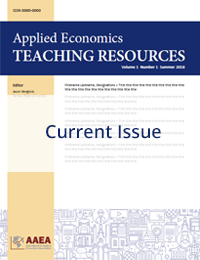Students’ Attitudes Toward Cooperative Learning in Online Classes
Carola Grebitus(a)
(a)Arizona State University
JEL Codes: JEL Codes: A2
Keywords: Active learning, cooperative learning, group projects, online teaching, and research-based teaching
First Published Online: October 9, 2024
Abstract
Active learning approaches allow students to excel at course material at higher cognitive levels. One of these strategies is cooperative learning, where students learn in small groups. This approach fosters retention, motivation, and critical thinking. In addition, using research-based teaching strategies where students can work hands-on on real-world problems improves learning outcomes. A fair amount of learning takes place online, which leads to the question of how research-based group projects can be included successfully in an online environment. This research aims to answer this question by studying undergraduate online students. The main objective is to shed light on students’ attitudes toward cooperative learning in online education. The main contribution is to highlight how a research-based group project can be incorporated in a fully online delivered course and how it is received by students. Key findings are that the majority of students agree that such an activity is a good opportunity to practice working in teams for future jobs. In particular women and those who hold a positive attitude toward group projects were most likely to view the research-based group project as good preparation.
References
Amaratunga, D., and S. Senaratne. 2009. “Principles of Integrating Research into Teaching in Higher Education: Built Environment Perspective.” International Journal of Construction Education and Research 5(3):220–232.
Boyer Commission on Educating Undergraduates in the Research University. 1998. Reinventing Undergraduate Education: A Blueprint for America’s Research Universities. Palo Alto CA: Carnegie Foundation for the Advancement of Teaching.
Bransford, J.D., A.L. Brown, and R.R. Cocking, eds. 2004. How People Learn: Brain, Mind, Experience, and School, Expanded Edition. Washington DC, National Academy Press.
Brown, R., N. Zuo, J. Shockley, and S. Buck. 2019a. “An Authentic Learning Approach to Group Assignments: An Analysis of Student Attitudes.” Applied Economics Teaching Resources 1(2): 1–13.
Brown, R., N. Zuo, J. Shockley, and S. Buck. 2019b. “The Project Manager/Private Contractor Approach to Group Assignments.” Applied Economics Teaching Resources 1(2):64–73.
Buckenmyer, J.A. 2000. “Using Teams for Class Activities: Making Course/Classroom Teams Work.” Journal of Education for Business 76(2):98–107.
Burke, M. 2022. “High Schoolers in Distance Learning More Likely to Be Lonely, Depressed.” EdSource. https://edsource.org/updates/high-schoolers-in-distance-learning-more-likely-to-be-lonely- depressed#:~:text=The%20UC%20Davis%20survey%20of,face%2Dto %2Dface%20classes.
Caspersz, D., M. Wu, and J. Skene. 2003. “Factors Influencing Effective Performance of University Student Teams.” Research and Development in Higher Education 26 (Proceedings HERDSA). Christchurch, New Zealand.
Chickering, A.W., and S.C. Ehrmann. 1996. “Implementing the Seven Principles: Technology as Lever.” AAHE Bulletin, October.
Espey, M. 2007. “Active Learning in the Classroom.” 2007 AAEA Teaching Academy.
Espey, M. 2018a. “Enhancing Critical Thinking Using Team-Based Learning.” Higher Education Research & Development 37(1):15–29.
Espey, M. 2018b. “Diversity, Effort, and Cooperation in Team-Based Learning.” The Journal of Economic Education 49(1):8–21.
Espey, M. 2022. “Variation in Individual Engagement in Team-Based Learning and Final Exam Performance.” International Review of Economics Education 41:100251.
Felder, R.M., and R. Brent. 1994. “Cooperative Learning in Technical Courses: Procedures, Pitfalls, and Payoffs.” http://www4.ncsu.edu/unity/lockers/users/f/felder/public/Papers/Coopreport.html
Gottschall, H., and M. Garcia-Bayonas. 2008. “Student Attitudes Towards Group Work Among Undergraduates in Business Administration, Education and Mathematics.” Educational Research Quarterly 32(1):3–28.
Greene, W.H. 2012. “Econometric Analysis. ” 7th ed. Pearson Education.Hair Jr., J.F., R.E. Anderson, R.L. Tatham, and W.C. Black. 1998. Multivariate Data Analysis, 5th ed. Hoboken NJ: Prentice Hall.
Joiner, C. 1998. “Concept Mapping in Marketing: A Research Tool for Uncovering Consumers’ Knowledge Structure Associations.” Advances in Consumer Research 25:311–317.
Kanwar, R., J.C. Olson, and L.S. Sims. 1981. “Toward Conceptualizing and Measuring Cognitive Structures.” Advances in Consumer Research 8:122–127.
Kim, J.-O., and C.W. Mueller. 1978. “Factor Analysis. Statistical Methods and Practical Issues.” In E.M. Uslaner, ed. Quantitative Applications in the Social Sciences. Newbury Park UK: SAGE Publications, Sage University Paper 07-014.
McGoldrick, K.M. 2012. “Using Cooperative Learning in the Economics Classroom.” American Economic Association Continuing Education Program. Advanced Interactive Teaching Methods in Economics, January 8.
National Student Clearinghouse Research Center. 2023. “Current Term Enrollment Estimates, Expanded Edition: Fall 2022. Appendix.” https://nscresearchcenter.org/current-term-enrollment-estimates/.
Paul, R., and L. Elder. 2019. The Miniature Guide to Critical Thinking: Concepts and Tools, 8th ed. Santa Barbara CA: The Foundation for Critical Thinking.
Pfaff, E., and P. Huddleston. 2003. “Does It Matter If I Hate Teamwork? What Impacts Student Attitudes Toward Teamwork.” Journal of Marketing Education 25(1):37–45.
Picault, J. 2021. “Structure, Flexibility, and Consistency: A Dynamic Learning Approach for an Online Asynchronous Course.” Applied Economics Teaching Resources 3(4):30–43.
Prince, M. 2004. “Does Active Learning Work? A Review of the Research.” Journal of Engineering Education, 223–231.
Salemi, M. 2012. “The What, Why and How of Interactive Learning.” American Economic Association Continuing Education Program. Advanced Interactive Teaching Methods in Economics, January 8, 2012.
Smith, K.A. 1996. “Cooperative Learning: Making ‘Groupwork’ Work.” New Directions for Teaching and Learning 67:71–82.
Tanner, K.D. 2013. “Structure Matters: Twenty-One Teaching Strategies to Promote Student Engagement and Cultivate Classroom Equity.” CBE—Life Sciences Education 12:322–331.
Welding, L. 2022. “Online Learning Statistics. Best Colleges.” https://www.bestcolleges.com/research/online-learning-statistics/#:~:text=In%202020%2C%205.4%20million%20college,%25)%20attend%20primarily%20online%20colleges.
Articles in this issue
The Kingmaker: Effective Teaching Approaches to Agricultural Policy
Logan L. Britton and Nellie Hill-Sullins
Students’ Attitudes Toward Cooperative Learning in Online Classes
Carola Grebitus
Nudging Agricultural Business Students into Successful Online Networking
Anthony R. Delmond
Responsible Conduct of Research for Graduate Students: What Should They Know?
Nixon S. Chekeny and Sukant Misra
Analyzing and Visualization of Data: A Team Project in an Undergraduate Course Evaluating Food Insecurity in U.S. Households
Yanhong Jin, Mattias Arrindell, Shannon Austin, Leann Benny, Jason Campbell, Qihong Chen, et al.


